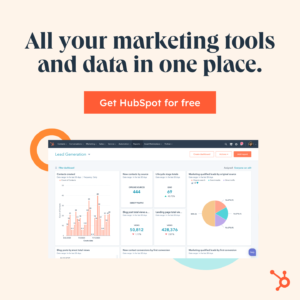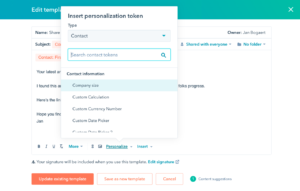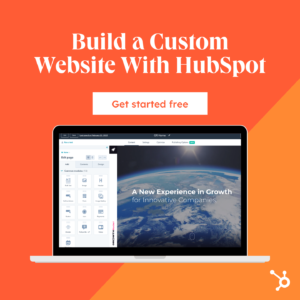The decision on adopting a CRM and marketing automation system can cause a lot of daily frustrations, loss of revenue, and sales-marketing misalignment.
Much of the publicly available advice is too heavily focused on content marketing and product/ticket selling.
It doesn’t apply very well to B2B enterprise services.
We need an integrated system that brings the strategy together, and doesn’t cause marketing and sales to work independently on isolated KPIs. That’s where HubSpot comes in.
 I thought I’d dig into some of my good (only some) and bad (obviously) experiences to share some insights. I have been engaged several times in making these decisions for both B2B technology services and product companies. For those just looking to improve their content marketing automation workflows, see this blog post on content strategy.
I thought I’d dig into some of my good (only some) and bad (obviously) experiences to share some insights. I have been engaged several times in making these decisions for both B2B technology services and product companies. For those just looking to improve their content marketing automation workflows, see this blog post on content strategy.
Note: Links to HubSpot CRM and Hubspot Marketing Hub in this post are my affiliate links and I receive a commission when you purchase. If you do decide to invest in HubSpot, let me know and I’ll help you set up.
Even thought in this post I’m recommending HubSpot CRM and marketing automation, I’m always very open to alternative strategies. So set up a call if you want to brainstorm your specific situation for free.
This analysis is specific to enterprise services
Every industry has a unique way of working. The approach that works for one, may not work very well for others.
For example, a lot of the marketing material we see for CRM and marketing automation systems is for product or high ticket offer companies – a tangible offer with a well defined price and implementation parameters.
But the cadence of a B2B services sales lifecycle is very different.
At the end of the day, one could argue that it’s all about moving leads through the sales process.
But if you are in B2B services sales and marketing, you know it’s not the same, is it?
Positioning, offer definitions, lead generation, and lead pursuits are all heavily industry and practice led with a focus on short term pipeline, and key relationships. Even brand marketing is often an enabling exercise. Every pursuit is unique, and every deal is different from another.
So, in this blog I prioritized the factors that are crucial to this industry.
At the end of the post, there’s also a total cost of ownership analysis to bring it all home. Definitely give that a look.
Factor 1: Bundled leads management system
The importance of this can’t be understated given the sweat and toil that goes into syncing a marketing automation system and a CRM that are different from each other.
There’s a marketing contact list, and then there’s contacts in the CRM. When we attend an event, we have multiple contacts who need to go into different places based on whether there’s a sales follow-up or a marketing follow-up. And then there are contacts which have been individually inputted by sales people based on their relationships.
In addition, existing service delivery issues and pending contracts need a silent period for those stakeholders. Naturally, the marketing and outreach activities are heavily scrutinized. Everyone wants to ensure that their clients have a great experience.
So, despite all the careful efforts, even the most committed and brave give up, and the end result is an out of sync system.
As a result, marketing automation is often reduced to sending batch emails when needed after a detailed contact database sync exercise. And the CRM operates independently. Marketing often has little to no visibility into the sales pipeline. And making sales aware of what’s coming is a challenge all of us can attest to.
Won’t it be much better if both sales and marketing could access the same system of record for each contact, and all activities are tracked in one place with the right access rights.
HubSpot is one of the few platform who can accomplish this easily and nicely.
Factor 2: Robust & easy to use CRM
Best of breed advocates would like to buy the best CRM as a standalone system.
But for our purposes, more bells and whistles mean more complexity. For example, the ability to create custom pipelines is great except when we need only 1 specific pipeline that everyone must follow.

What we really need is a good way to segment contacts by vertical and horizontal, send prospects and clients personalized or automated sales (not marketing) messages, and see a solid dashboard of leads and opportunities by source for both new and prospective clients, and which partners if any are attached to them. In addition, we need to be able to run multi-channel sales outreach on phone, SMS, social, and email.
Combine this with the fact that your marketing team uses the same system, it’s a no brainer to use HubSpot. HubSpot has also been one of the leading players to integrate AI so it is really intuitive and easy to use.
Factor 3: Marketing Automation, Website Builder, Lead Generation & Branding
Analyze your website. It’s a collection of services and industry pages, solutions, partners, blogs, and a few pages on leadership etc.
 There aren’t many options around to create a good flexible website, and in the interest of scalability and cost, most of us decide to create this on WordPress.
There aren’t many options around to create a good flexible website, and in the interest of scalability and cost, most of us decide to create this on WordPress.
It’s true that WordPress is very flexible and has an extensive plugin ecosystem. But with that comes complexity. I haven’t yet met a marketer who didn’t need developer support while designing and creating their WordPress website.
The bundled system I mentioned above extends to this too. HubSpot provides a powerful CMS or website builder out of the box. I’ve used it to create pages, blogs, and navigation, and it’s as easy, if not more than a typical WordPress installation. Your HubSpot website and landing pages does not need special connectors and scripts to connect to your marketing automation system.
On top of that, you don’t have to worry about hosting or security. And all of the analytics on traffic, bounce rates, hotspot analysis, visitor origin analysis etc., is available just the way you like it. If you need external plugins and integrations, there’s plenty of those too.
For lead generation and client engagement, most tools such as Evalinator integrate with HubSpot. And HubSpot provides many tools to get started in a native way too.
Total cost of ownership
The cost of HubSpot sales and marketing subscription seems expensive no doubt. Professional versions of sales hub starts at $450 per month for 5 users. Professional marketing hub (includes email, websites, social) starts at ~$800 per month. While discounts are available when you sign up, it’s still a significant investment.
That seems like a lot for a team operating on a budget. Especially if you are a tiny team with 1or 2 sales persons and not much going on in marketing.
But, if you are a growing company building up a sales team, investing in inside sales and account management, and marketing, then you will see the costs very differently. If you run separate systems, your costs can easily run up very quickly. That’s because you’ll add a decent sized contact database, upgrade your website, and add more sales users very quickly. In addition, the additional effort spent in keeping the systems in sync will drag down your effectiveness.
As a result, if you are a growing team, then HubSpot is a good option to consider for your CRM and marketing automation needs. The biggest benefit is a bundled system that really simplifies operations while enabling growth focused execution.
If you want to go the HubSpot route, you can get started with a free CRM, and also a low cost starter bundle. As an HubSpot partner, I can help you analyze the right option, and help you set it up quickly too.

